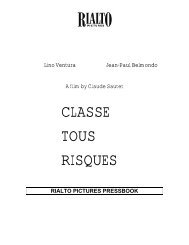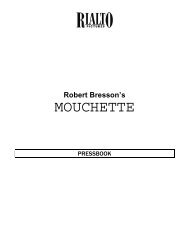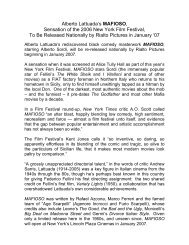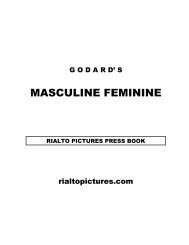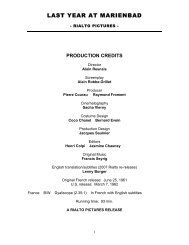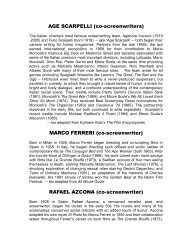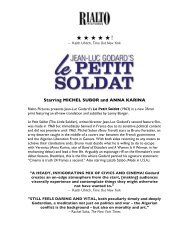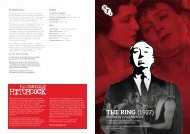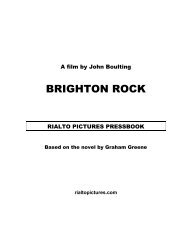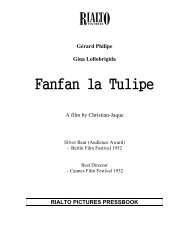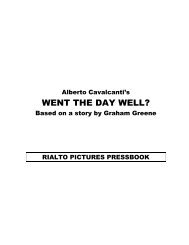Two or Three Things I Know About Her - Rialto Pictures
Two or Three Things I Know About Her - Rialto Pictures
Two or Three Things I Know About Her - Rialto Pictures
You also want an ePaper? Increase the reach of your titles
YUMPU automatically turns print PDFs into web optimized ePapers that Google loves.
Godard’s impact on the cinema of the 60s was monumental and sweeping. He<br />
used the camera inventively, re-writing the syntax of films along the way.<br />
Masculine Feminine (1966, re-released by <strong>Rialto</strong> in 2005) was a free-f<strong>or</strong>m study<br />
of the m<strong>or</strong>es of Parisian youth. Made in USA (1966) was based on an American<br />
potboiler. <strong>Two</strong> <strong>or</strong> <strong>Three</strong> <strong>Things</strong> I <strong>Know</strong> <strong>About</strong> <strong>Her</strong> (1967) told the st<strong>or</strong>y of a Paris<br />
housewife who moonlights as a prostitute. La Chinoise (1967) featured in the<br />
leading role actress Anne Wiazemsky, who became Godard's second wife.<br />
After Week End (1968), a new Godard surfaced, a revolutionary, didactic<br />
filmmaker who became obsessed with the spoken w<strong>or</strong>d and increasingly<br />
apathetic to cinema as a visual medium. He dedicated himself to making<br />
"revolutionary films f<strong>or</strong> revolutionary audiences." In the late 70s Godard<br />
underwent yet another metam<strong>or</strong>phosis, rediscovering himself and his love of film.<br />
He refocused his sights on themes of universal humanistic concern in Every Man<br />
f<strong>or</strong> Himself (1980), Passion (1982), and First Name: Carmen (1983). He even<br />
paid a renewed homage to American cinema in Détective (1985), but caused<br />
massive controversy with his Hail Mary! (1985).<br />
King Lear (1987) was an unsuccessful attempt to film Shakespeare. Soigne ta<br />
droite (1987), Nouvelle Vague (1990) and Hélas pour moi (1994) all featured top<br />
stars, but his F<strong>or</strong> Ever Mozart (1997), with its typically Godardian disquisition on<br />
art and war, was the best received of the four. In 1998, Godard completed his<br />
long-gestating Histoire(s) du Cinéma, a highly personal meditation on 100 years<br />
of cinema, which was released on video and in book f<strong>or</strong>m. Other w<strong>or</strong>ks of the<br />
90s include Germany Year 90 Nine Zero, and the self-p<strong>or</strong>trait JLG/JLG (1995).<br />
In 2003, he made In Praise of Love, a surprisingly moving study of art, hist<strong>or</strong>y,<br />
madness and exploitation and, in 2004, Notre Musique, shot on location in<br />
Sarajevo. M<strong>or</strong>ceaux choisis (literally, “choice bits”), a 90-minute re-edit of his<br />
Histoire(s) du Cinéma, was shown in 2004 at the Pompidou Center in Paris and<br />
was the opening night film of the re-opened Museum of Modern Art in New Y<strong>or</strong>k.<br />
Among his many prizes and hon<strong>or</strong>s, Godard won the best direct<strong>or</strong> award at the<br />
Berlin Festival f<strong>or</strong> Breathless, a Berlin Jury Prize f<strong>or</strong> A Woman Is a Woman, and<br />
Venice’s Golden Lion (Best Film) f<strong>or</strong> First Name: Carmen. In 1986, he was<br />
hon<strong>or</strong>ed with a Special French César Award f<strong>or</strong> lifetime achievement. Earlier this<br />
year, the Pompidou Center held the most complete Godard retrospective to date.<br />
Adapted from Ephraim Katz’s Film Encyclopedia; updated by Lenny B<strong>or</strong>ger<br />
19



